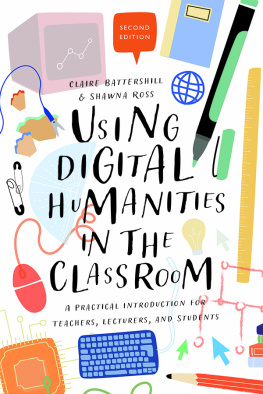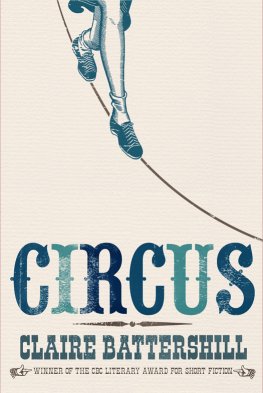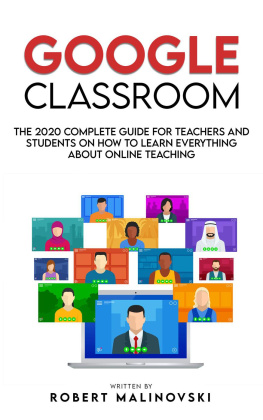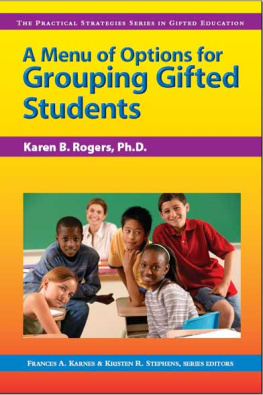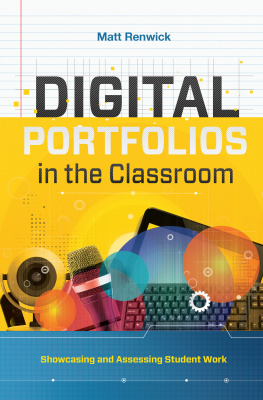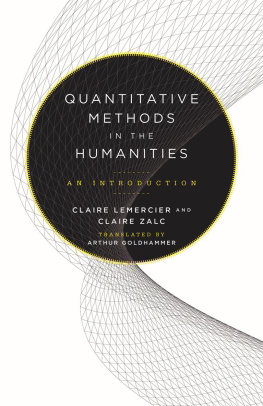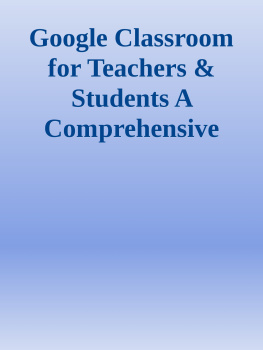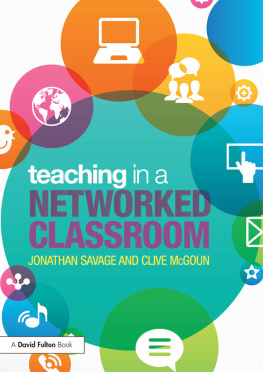Claire Battershill - Using Digital Humanities in the Classroom: A Practical Introduction for Teachers, Lecturers, and Students
Here you can read online Claire Battershill - Using Digital Humanities in the Classroom: A Practical Introduction for Teachers, Lecturers, and Students full text of the book (entire story) in english for free. Download pdf and epub, get meaning, cover and reviews about this ebook. year: 2022, publisher: Bloomsbury, genre: Romance novel. Description of the work, (preface) as well as reviews are available. Best literature library LitArk.com created for fans of good reading and offers a wide selection of genres:
Romance novel
Science fiction
Adventure
Detective
Science
History
Home and family
Prose
Art
Politics
Computer
Non-fiction
Religion
Business
Children
Humor
Choose a favorite category and find really read worthwhile books. Enjoy immersion in the world of imagination, feel the emotions of the characters or learn something new for yourself, make an fascinating discovery.
- Book:Using Digital Humanities in the Classroom: A Practical Introduction for Teachers, Lecturers, and Students
- Author:
- Publisher:Bloomsbury
- Genre:
- Year:2022
- Rating:3 / 5
- Favourites:Add to favourites
- Your mark:
- 60
- 1
- 2
- 3
- 4
- 5
Using Digital Humanities in the Classroom: A Practical Introduction for Teachers, Lecturers, and Students: summary, description and annotation
We offer to read an annotation, description, summary or preface (depends on what the author of the book "Using Digital Humanities in the Classroom: A Practical Introduction for Teachers, Lecturers, and Students" wrote himself). If you haven't found the necessary information about the book — write in the comments, we will try to find it.
Using Digital Humanities in the Classroom: A Practical Introduction for Teachers, Lecturers, and Students — read online for free the complete book (whole text) full work
Below is the text of the book, divided by pages. System saving the place of the last page read, allows you to conveniently read the book "Using Digital Humanities in the Classroom: A Practical Introduction for Teachers, Lecturers, and Students" online for free, without having to search again every time where you left off. Put a bookmark, and you can go to the page where you finished reading at any time.
Font size:
Interval:
Bookmark:

Using Digital Humanities in the Classroom
Using Digital Humanities in the Classroom
A Practical Introduction for Teachers, Lecturers, and Students
Second Edition
Claire Battershill and Shawna Ross

CONTENTS
For this updated edition, we would first like to thank Hoyeol Kim, a PhD candidate at Texas A&M who is currently applying machine learning to Victorian literature for the purposes of sentiment analysis and image coloration. He worked throughout Summer 2020 as a graduate student researcher to flag obsolete software recommendations and URLs from the first edition of this book. He also recommended fantastic replacements for these outdated references and helped us brainstorm ideas for new activities and assignments. You can see more of his exciting work at https://github.com/elibooklover.
Next on our list is Andrew Pilsch, who programmed the live, searchable Web Companion. To look under the hood of the Web Companion and view his other JavaScript projects, browse https://github.com/oncomouse.
Many colleagues shared their own pedagogical tips and tricks with us, including Heather Jessup (Dalhousie University), Sheryda Warrener (the University of British Columbia), Suzannah Showler (University of Ottawa), Kate Ozment (Cal Poly Pomona), Emanuel Istrate (Victoria College, University of Toronto), Deanna Stover (Christopher Newport University), and Elaine Thompson (Louisiana Tech). If we have forgotten to list you here, we apologize and owe you a coffee the next time we cross paths at a conference!
We are indebted to multiple editors and assistants at Bloomsbury, including Ben Doyle, Lucy Brown, and Laura Cope. Wed also like to acknowledge our original acquisitions editor, David Avital, who was a great supporter of the project in its early days.
Claire would like to thank Cillian OHogan for his editorial suggestions. She would also like to thank the organizers and everyone who attended the 2018 Digital Pedagogy Institute (DPI) conference at Brock University, where she was delighted to give a keynote talk and to learn from inspiring colleagues. For pedagogical development she has appreciated the ACUE Effective Online Teaching Course hosted by the University of Toronto in the winter semester of 2021.
Shawna would like to thank the instructors who taught her at DHSI: Constance Crompton, Ian Gregory, Jonathan Martin (twice lucky!), John Maxwell, Emily Christina Murphy, Jon Saklofske, Erin Templeton, George H. Williams, and Lee Zickel. The volunteer labor of DHSI instructors is absolutely crucial to the growth and health of DH.
Finally, thanks to our readers, both those who participated in the review process at Bloomsbury and those readers who read the first edition. We are especially thankful for the librarians, instructors, and reading-group leaders whove adopted the book as a course text or included it in library guides, as well as for those who have written to us with their ideas about what makes for an exciting and effective classroom.
To say a lot has happened in the world and in Digital Humanities (DH) since the first edition of this book was published five years ago is a bit of an understatement. Indeed, the critical discourse into which we enter with this updated edition has been almost unrecognizably transformed when it comes to the use of digital methods in humanities classrooms. Since 2016, digital activities and assignments have become far more common, and curricular offerings in DH (majors, minors, certificates, tracks, and interdisciplinary programs) are far more readily available. And since then, almost all university instructors, even those who had never previously even opened up their institutions online learning management systems, were thrown suddenly into fully remote teaching in the spring of 2020. We respond to these dramatic shifts here in part by addressing the impact of the Covid-19 pandemic and the sudden ubiquity of Zoom teaching, online discussion boards, and virtual classrooms in our new chapter on Teaching in a Digital Classroom.
We first decided to create this text back in 2015 in response to an increasing demand for an entryway into pedagogical digital tools and methodsan introduction that was truly accessible and inclusive. We took then (and continue to take) a very broad approach to the notion of digital humanities and intend to mean by it, in a general way, the application of humanistic methods of thinking to digital tools and environments. In this book, DH is not intended to represent a monolithic critical edifice but rather a very broad term to cover any and all intersections of humanistic work and digital tools and infrastructures. You dont need a fancy lab, a ton of funding, a background in coding, or even a lot of extra time to engage meaningfully and thoughtfully with technology in the humanities classroom. In fact, we all use basic technologies all the time in teaching, and this book is designed in part to encourage thoughtful approaches to straightforward, everyday tools.
Often, a half-decade ago, new initiates into digital methods would find themselves spending inordinate amounts of time parsing jargon borrowed from computer science (and sometimes, upsettingly, shamed for lacking technical skills). They might try out many new digital assignments or apps or platforms, only to discover that the technological solution in question wasnt right for their students or their subject. We aimed to create a manual that would help the DH-skeptical and the DH-nervous (and even the generally technophobic) get started. It would help them find out if there was anything potentially generative in this field that might align with their own teaching philosophies and values. We also hoped that this book would help graduate students learning to teach, liaison librarians new to the field, and instructors and faculty members in many types of institutions. We hoped it would become part of an academic community that shares nuts-and-bolts practical knowledge of classroom techniques of the kind that should be openly available rather than guarded. We have been delighted to see at conferences and in reading groups and training sessions that small, intrainstitutional communities often develop around learning about digital approaches to teaching in the humanities and around shared pedagogical practices.
Since we wrote the first edition, some other excellent beginner-friendly resources have been published. These include, particularly, Digital Pedagogy in the Humanities: Concepts, Models, and Experiments , edited by Rebecca Frost Davis et al., and the upcoming Debates in Digital Humanities Pedagogy , edited by Brian Croxall and Diane Jakacki, both of which would form excellent companions to the present volume. There has also been a turn in the overall dynamic of the field of DH as a scholarly discipline. Initial optimism about the promise of the discipline for the future has given way to skeptical critiques and takedowns on subjects ranging from diversity and inclusion, to the lack of reproducibility of some quantitative results, to the funding infrastructures that support large-scale projects. Indeed it has been accused of many evils, including a potential contribution to the decline of the status of the humanities in universities (evidenced by declining enrollments in some humanities subjects and the weak job market for humanities PhDs in many countries). We have followed these ongoing debates with interest and engagement and we celebrate the rise of the critical digital humanities: bodies of scholarship that are rectifying these problems in DH by approaching the field from the lenses of critical race theory, intersectional feminism, and disability studies.
Next pageFont size:
Interval:
Bookmark:
Similar books «Using Digital Humanities in the Classroom: A Practical Introduction for Teachers, Lecturers, and Students»
Look at similar books to Using Digital Humanities in the Classroom: A Practical Introduction for Teachers, Lecturers, and Students. We have selected literature similar in name and meaning in the hope of providing readers with more options to find new, interesting, not yet read works.
Discussion, reviews of the book Using Digital Humanities in the Classroom: A Practical Introduction for Teachers, Lecturers, and Students and just readers' own opinions. Leave your comments, write what you think about the work, its meaning or the main characters. Specify what exactly you liked and what you didn't like, and why you think so.

